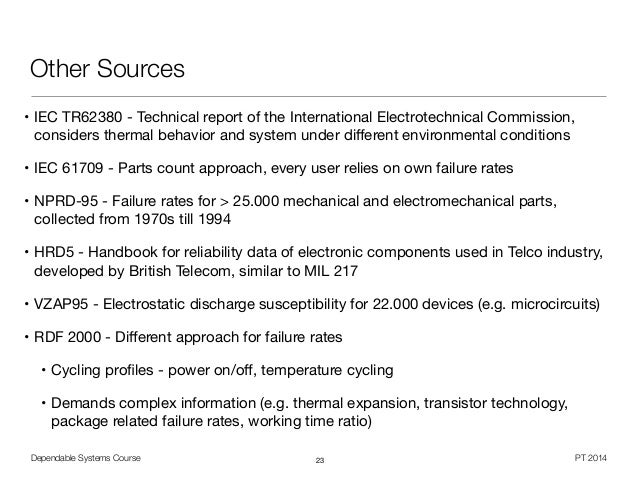Rdf 2000 Reliability Data Handbook 44
Nevertheless, predictions are a valuable form of analysis that also provide insight into safety, maintenance and warranty costs and other product considerations. US Department of Defence Handbook (MIL-HDBK-217 F, dd Dec 1991) can be used for reliability prediction of electronic components (e.g. Microcircuits, semi-conductors, lasers, resistors, capacitors, etc.). 11 The purpose of MIL-HDBK-217 isto establish and maintain consistent and uniform methods for estimating the inherent reliability (i.e., the reliability of a mature design) of military electronic equipment and systems. It provides a common basis for reliability predictions during acquisition programs for military electronic systems and equipment. It also establishes a common basis for comparing and evaluating reliability predictions of related or competitive designs.
Rdf 2000 Reliability Data Handbook 44 7
The handbook is intended to be used as a tool to increase the reliability of the equipment being designed. This handbook contains two methods of reliability prediction – ‘Part Stress Analysis’ (in Sections 5 through 23) and ‘Parts Count’ (in Appendix A). These methods vary in the degree of information needed to apply them:.The part stress analysis method requires a greater amount of detailed information regarding the components and is applicable during the later design phase when actual hardware and circuits are being designed. It therefore offers a more accurate estimate of failure rate.The parts count method requires less information, generally part quantities, quality level, and the application environment. This method provides a simpler reliability math 12 and is applicable during the early design phase (e.g. During proposal formulation) when detailed information is not available, or a rough estimate of reliability is all that is required.In general, the parts count method will usually result in a more conservative estimate (i.e.
Higher failure rate) of system reliability than the parts stress method.Even though this handbook is no longer being kept up to date by the US military, it remains the most widely used approach by both commercial and military analysts. Other commonly used electronic reliability prediction approaches include Bellcore, RDF 2000, PRISM, Physics of Failure and the IEEE Gold Book (see Appendix A for more information).



Reliability prediction (i.e. Modeling) is the process of calculating the anticipated system RAMS from assumed component failure rates.
It provides a quantitative measure of how close a proposed design comes to meeting the design objectives and allows comparisons to be made between different design proposals.